#chicken cassoulet
Photo

Hearty French Chicken and Sausage Cassoulet
0 notes
Text
Marauders era characters and their favorite foods
Lily Evans: She LOVES strawberry’s. She will have anything strawberry flavored and that what she says.
Marlene Mckinnon: Marlene would love steak. Just well seasoned steak and she’d be perfectly fine.
Mary Macdonald: thin mints. i will not elaborate.
Sirius Black: Cassoulet. He was so used to eating fancy foods and Effie made this for him when he ran away.
Remus Lupin: anything chocolate. if it contains chocolate he’ll eat it right up munch much chomp chomp
James Potter: He starts crying when people ask him to choose between Chicken Korma and salmon.
Peter pettigrew: he LOVESSSS salads. He loves literally any kind of salad.
Dorcas Meadowes: She really likes grapes but her favorite dish is Tacos.
Pandora Rosier/Lovegood: she found out about fairy bread and tried it, had a mental breakdown over how good it was and now eats it for breakfast every day. and cinnamon rolls.
Regulus Black: he absolutely adores mac and cheese with hot dogs and that’s that
Barty Crouch Jr.: THIS MAN LIVE LAUGH LOVES GARLIC BREAD HE JUST LOVES IT
Evan Rosier: if you give him some well seasoned chicken wings he’ll be happy
#james potter#sirius black#remus lupin#jegulus#sirius x lupin#wolfstar#regulus and evan and barty#sirius#sirius and regulus#remus and regulus#maruaders era#the marauders era#dead wizards from the 70s#dead gay wizards from the 70s
102 notes
·
View notes
Text

FFXIVWrite 2024 - Day 15: Free Day
LA BATARDE
ENTREE
Soupe au Pistou
Pistou Soup
Soupe à l'Oignon
Onion Soup
Gougères
Sauteed Pastry With Cheese
Lentilles Du Puy Mijotées
Simmered Du Puy Lentils
MAINS
Cassoulet de haricots, saucisse fumée et poulet
Cassoulet of Beans, Smoked Sausage, and Chicken
Ratatouille de légumes d'été
Ratatouille of Summer Vegetables
Coq Au Vin
Stewed Poultry In Wine
Fricassée de poulet au pain grillé
Chicken Fricasee With Toasted Bread
DESSERT
Fromages d'Eorzea
Cheeses Of Eorzea
Crêpes aux baies de Gridania et sirop
Crèpes with Gridanian Berries and Syrup
Tarte aux pommes avec glace
Apple Tart With Iced Cream
5 notes
·
View notes
Text
Come the warm, ripening days of summer and I imagine that I am closer to a more ancient, basic and healthful style of vegetable and grain eating than in my cold and meaty winters. I am seduced by my garden and neighboring farm stands vivid with color and flavor.
I avoid a lot of hot time in the kitchen. Much is eaten raw or almost: vegetable soups - gazpacho has many names and many recipes - vegetable sauces for rice or pasty and endless salads. I have corn on the cob and other vegetables in every form: grilled, roasted, steamed, stir-fried, puréed and combined in a variety of stews to be eaten hot, cold and at room temperature. Fresh herbs, garlic, onions and imagination sauce the dishes. The first beans from the pod or dried beans, fruit, cheese, bread and wine complete my menus.
There is almost no meat and little chicken or fish - an occasional grilling, a stew more vegetable than meat, a slice of cold meat or charcuterie, a boiled egg, a little tuna from the can.
I eat this way for pleasure as well as in a modern quest for a more healthful diet. Those came before us ate this way to take advantage of what they had - often limited. While we tend to see a cornucopia-vision of the past, rich in more seasonal, more natural foods, it is only partly true.
Winter in most climates was short of fresh vegetables, and the world relied on salting, pickling, drying and cold storage for any vegetables at all. The animal protein we are fending off today was in short, expensive supply.
With the best will in the world and without an evil intention, food writers and the natural inclination of all of us to glamorize the past and the far away have been guilty of distorting our view of the way the world eats. By selecting the best, the most festive food of other places or times, we have come to see them as halcyon visions of plenty, filled with meat and seafood, sugar and cream.
It is not sugarplum fairies, but roasts and fries, sausages and sautés, stews and cassoulets that frolic in our Rabelaisian dreams. Southern picnics are enriched with baked hams and fried chicken. Clambakes clutter the shores of a mythical New England. In that world of the imagination, native Africans are awash in chicken and ground-nut stew, native Americans feast on venison and buffalo, Greeks expand over countless dishes of succulent lamb, the Chinese are exquisite in damask while dining on unimaginably choice viands.
The English eat hearty roasts, silken salmon, and mountains of oysters. The French of the mind are various, either robust peasants glorying in rich stews or jeweled aristocrats whose famous chefs set forth succulent sauces. Our Italians live in a world of perpetual holidays, their risotti topped with pungent white truffles.
While not totally untrue - these foods did exist in each of these countries and were eaten by the natives at least upon occasion - such visions falsify the totality of real experience and may contribute to the glut of fat and cholesterol in our lives. We equate these festive foods with good living and think that ,if we can, we should eat this way all the time.
Our ancestors and many peoples all over the world today eat very differently from this skewed perception. Carbohydrate, or stodge, was what really fed and filled up most people. With bread as the staff of life in Europe, scarcity led to bread riots for centuries. Even in the recent past, when the government-fixed price of bread was raised in France, the announcement was carefully scheduled for August when almost all Frenchmen are on vacation.
Certainly, the staple food of the vast majority of the world is still rice, followed by bread and potatoes along with noodles - pasta among them - soy foods, yams, taro, yucca, corn, beans, pulses such as lentils, myriad grains and other starchy foods with names foreign to me. In the past and in much of the present, animal protein, when available, has been primarily a flavoring.
Beasts were not killed promiscuously. They were the cash crops and the providers of the milk and eggs. If a pig was slaughtered in the fall, that was a major event, and a family would hoard the preserved hams for Christmas and Easter, or sliver small amounts for a taste at many meals. A prosciutto bone or other ham bone was an asset to be used and reused in soups until flavorless. Fresh meats were rare; only the overage animal or the single, religiously festive springling was sacrificed.
To envisage a chicken in every pot was to dream of luxury indeed - the most luxurious of Sunday dinners.
if other meats were salted and smoked like bacon, or pickled like corned beef, air-dried like grisson or jerky, or preserved in fat like confit, it was to keep them over the winter and dispense them parsimoniously as special treats.
So when we read recipes for peasant dishes crammed with meat, we should remember we are reading about rare treats, not daily fare. Even fishing nations could have uncertain catches, rough seas and months when it was impossible to put out upon the water. Even plenty might need to be sold. A home-cooked paella was mainly rice, seasonings, oil and vegetables.
The great go-along-withs have been vegetables and fruits, fresh when in season, pickled or preserved for inclement times. A little fat would have come from the possibilities of each region - olive oil, butter and lard. Food was about survival and pleasure when possible. No one got more than nutritionally sound share of meat and fat over the course of a year. It is these daily recipes that are by and large missing or recorded primarily as accompanying dishes in our cookbooks and kitchens.
It is up to us to re-create out of our plenty the sane eating and pleasures that scarcity and invention, herb patch and garden, bestowed on our forebears.
"The Real Past", from The Opinionated Palate: Passions and Peeves on Eating and Food by Barbara Kafka
8 notes
·
View notes
Text
Heirloom Kitchen, Old Bridge NJ
My wife and I enjoyed an absolutely first class dining experience today at Heirloom Kitchen in Old Bridge, NJ.
Food was good, almost shockingly good. I was taken aback at the subtlety of just about every dish we were served. Atmosphere was clean and quirky, somewhere at the intersection of cottagecore, industrial, and kitch. Service was top notch, attentive and professional, from a brigade that couldn't have been much older than my teenage sons.
The menu was a four course prix fixe, including dessert ($89 pp). Tonight's menu featured three or four choices for each course, so we had (difficult!) choices to make. As usual, we ordered extras: a stuffed bread course (which was amazing, both sweet and savory, with onion jam and a whipped feta spread), as well as two a la carte dishes as an additional course, (which the staff sequenced perfectly, despite our last minute addition).
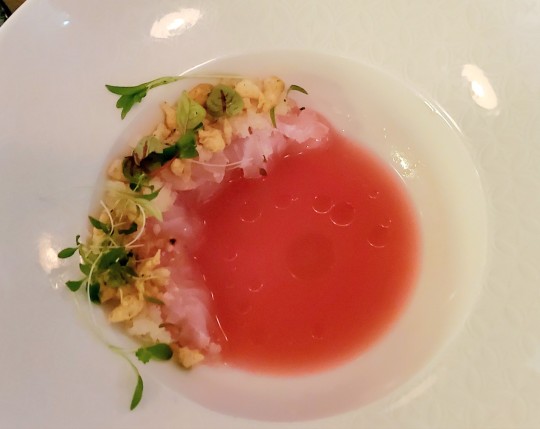
Our first course was a raw cured snapper served in watermelon lime broth and a chicken liver mousse served on brioche. The snapper was served like ceviche, cured in citrus, but served over a vivid red watermelon broth. The flavor of the lime oil popped with the crisp texture of the fish, and rode nicely over the sweetness of the watermelon.
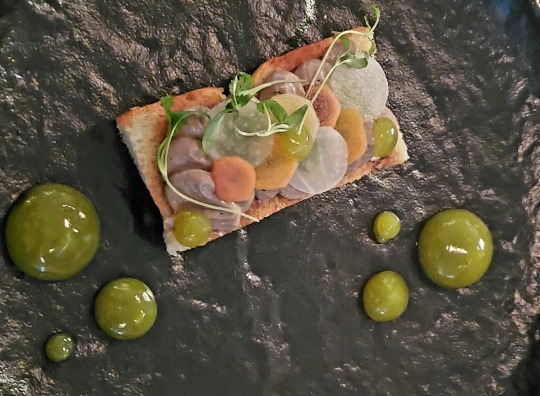
The toasted brioche was topped with a modest shmear of a velvety chicken liver mousse, which would have been a sensational pairing all by itself. But the bite was taken up several notches with the addition of pickled veg, micro cilantro, and emulsified jalapeno on the plate. The acidic and mildly-spicy pop was so helpful to cut the cloying fattiness that normally comes with chicken liver. Very well balanced and clever to keep the spicy element separate on the plate, allowing the diner to dial in their preferred level of heat.
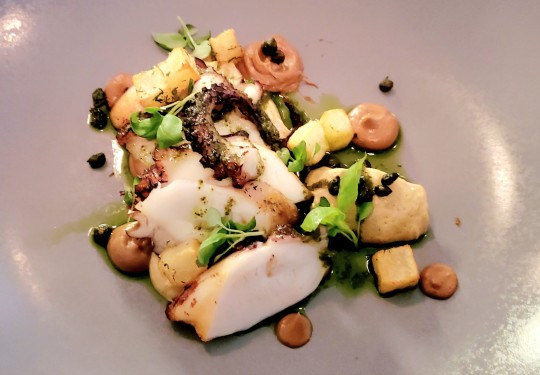
Course number two consisted of grilled octopus and a baked squash. The octopus dish was a master class in the Maillard reaction: just about every item on the plate was cooked to caramelization, but not a single element had that burnt flavor you get when something is left in the pan a few minutes too long. Eggplant, nuts, capers, potato, and even the za'atar - each cooked to its own smoky sweetness then combined perfectly in a harmony like an exquisite campfire.

The Delicata squash was served in tender cubes over acorn squash rendered as a mousse and had several different textures across the dish. The apple mostarda complimented the squash in both a expected yet surprising way. That familiar homey flavor of simple baked apples with squash and cinnamon took on a much more sophisticated demeanor in this context.
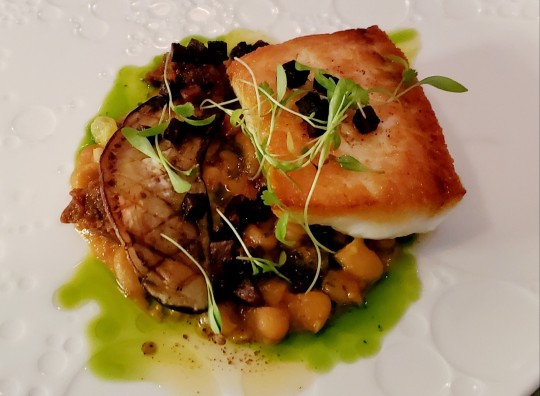
Our third course was a pan-seared fluke and a pork belly deconstructed "tamale". The fish had a great crust and flavor, but could have maybe used one minute less in the pan. But we like our fish under rather than over, so it might have been personal preference. The pepperoni butter was the most surprising element, and one we are going to try to replicate. Each of the other elements - the cassoulet, the sofrito, and the caponata - were executed well enough to stand on their own; in combination, they supported the fluke without overwhelming it.
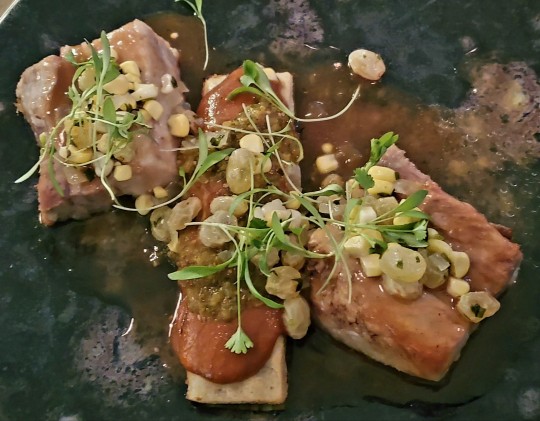
The pork belly was cooked "birria" style, a slow-cooked stew with meat and spices. This dish was clever and incredibly flavorful, with a generous portion of extremely moist and tender pork belly. The corn portion of the deconstructed tamale was served central to the dish, as a simple rectangle covered in the mole sauce. I enjoyed the texture that the corn and wax beans added to the dish, especially given the silky tamale/mole centerpiece. My only wish was that they had gone with a birria "tatemada" style of cooking, where the pork belly was crisped up after being stewed. I missed the sensation of crispy pork fat in my tamale, and I worry that the large moist fat cap on the pork belly might turn off some patrons. But that's just a tiny tweak, not at all a complaint.

Our bonus course consisted of a pasta dish (Sorpresine), and the duck breast we thought we had to sacrifice in lieu of the pork belly. When our server told us in casual conversation that we could add dishes a la carte, we jumped at the chance to fill in with some of the dishes we had missed. Sorpresine (meaning "little surprises") is sort of an unstuffed version of ravioli. Just folded and cooked, this pasta was served with a sticky-sweet peach agrodolce, tiny tomatoes, and a very moist stracciatella cheese, sister to ricotta. We were so pleased we were able to get this complex yet rustic dish into our menu. It simultaneously felt subtle and lush in my mouth while being reminiscent of Sunday dinners at my grandma's house.
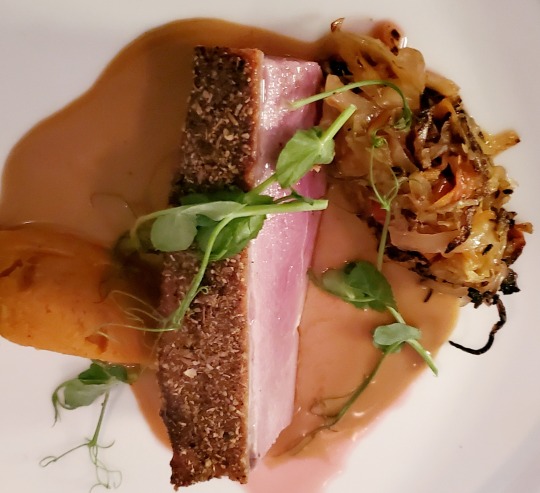
The duck breast was served in a Jamaican style, with a dry jerk rub, a habanero jus sauce, and braised cabbage and squash. The large portion of duck breast was cooked perfectly medium rare, a lovely light warm pink in the center. We cut it into medallions, and smeared each through the spicy jus. While I loved the flavor, I really wanted a more substantial jerk sauce, sticky and clinging to the meat. This dish had such an island inspiration but fell slightly short on the thin jus. The cabbage was tasty but slightly overly-salted to my palate. All of the other flavors were spot on, however, and I wouldn't hesitate to order it again.
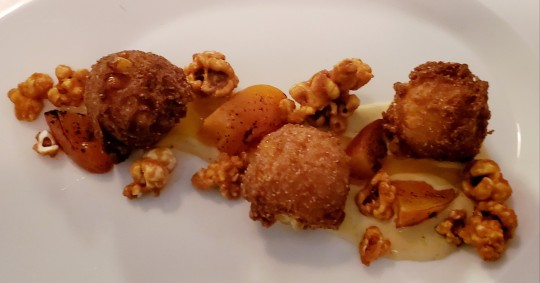
Last course was dessert: we had the hush puppies, and the inspired combination of basil mousse/olive oil cake/Parmesan ice cream. I have to admit I wasn't wild about the hush puppies. Served with caramel popcorn and a smear of creme "elote" anglaise, this clearly chef-inspired dessert fell flat for me. I wanted more fresh in-season fruit, instead of the one lonely bit of peach and gooseberry. I wanted more delicious sauce, instead of the tiny smear. The hush puppies and popcorn were fine but their focus should have been reversed, IMO.

The other dessert was a delightful exercise in contradiction and challenging your preconceptions. Basil mousse, parmesan ice cream, olive oil cake, pine nut brittle - this sounds like the ingredients to a nice savory pesto dish, not a dessert. However, here's a chef's dessert that knocked the ball out of the park on so many levels. The olive oil cake was a moist platform for the ice cream and a tart lemon curd. The pine nut brittle paired as expected with the basil ice cream but the surprise was that it works as a sweet dessert as well as in a savory main. This dish was just over-the-top clever in its conception, almost like it was the response to a dare: "Make a pesto dish, but dessert - go!" However the good balance of sweetness and acid from the lemon and texture from the brittle, all melting together and soaking into the tight crumb of the cake was so startling in its "challenge accepted", perfect execution.
Again, service staff was exquisite, more attentive than many restaurants asking twice the price. Busers were on the move continuously but not obtrusive. Runners knew their food preparation and could answer questions thoughtfully. Our server was funny, engaging, offering her own thoughts and opinions while remaining thoroughly professional throughout
Decor was an interesting mix. Edison bulbs, black fixtures and flatware. Seating that matched but also seemed to come from a yard sale. A library of cookbooks and an open kitchen all contributed to the informal, casual feel. I thought the music was at times a bit too loud for easy conversation though. Our server told us the restaurant started life as a cooking school, and in fact still offers cooking and baking classes, as well as a multi-course tasting experience on Sundays.
Please forgive the extensive review here. I feel like this restaurant is quite possibly one of the best in the state. More than being a "hidden gem", this experience was easily a 5-star fine-dining experience, tucked into a little strip mall off Route 9 in Old Bridge. I literally do not know if they're aware of the incredibly high quality of the experience they offer, and the value you get as a patron. But I suggest you bring an adventurous palate and a few friends for dinner at Heirloom Kitchen before they wise up, put linen tablecloths over their neat wooden tables, and double the prices. But even if that happens, you can count on seeing me there (just wearing my jacket and tie).
Happy Eating!
12 notes
·
View notes
Text
I spent SIX HOURS smelling my beautiful cassoulet stewing (read: beans and pork and bacon ends and wild rice sausage and chicken) and I finally ATE IT but the tragedy here is I cannot eat another bowl bc I am now a STUFFED GOOSE
#cw food#full disclosure I made this a proper Fuck England stew by adding potatoes#meanwhile in minnesota#we only have a dusting of snow and it’s been unseasonably warm but that means ‘hovering around freezing’ which is my LEAST favorite temp#bc it’s so humid and damp that it feels horribly bitter#I stfg give me 10° over 30° it is FAR more comfortable 🫣#but also I spent half the day outside yesterday so it was absolutely time to break out my coziest recipe
3 notes
·
View notes
Text

#food#please if you can please make this#Very unhealthy#Very delicious#Languedoc#cassoulet#I swear the combination of meats and fats and slow cooking goes straight to the neanderthal brain#I leave the chunks of carrot and celery in for an extra treat#One day I will attempt to make this vegan and see if I can get the same flavour and texture#but today is not that day
13 notes
·
View notes
Photo


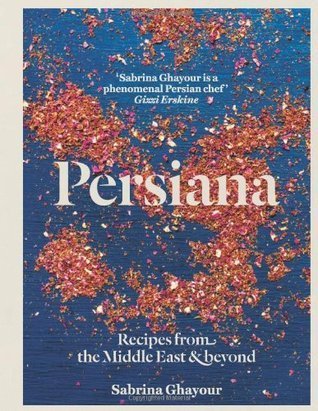

Nonfiction Thursday: Cookbooks from Around the World
My Paris Kitchen by David Lebovitz
It’s been ten years since David Lebovitz packed up his most treasured cookbooks, a well-worn cast-iron skillet, and his laptop and moved to Paris. In that time, the culinary culture of France has shifted as a new generation of chefs and home cooks—most notably in Paris—incorporates ingredients and techniques from around the world into traditional French dishes.
In My Paris Kitchen, David remasters the classics, introduces lesser-known fare, and presents 100 sweet and savory recipes that reflect the way modern Parisians eat today. You’ll find Soupe à l’oignon, Cassoulet, Coq au vin, and Croque-monsieur, as well as Smoky barbecue-style pork, Lamb shank tagine, Dukkah-roasted cauliflower, Salt cod fritters with tartar sauce, and Wheat berry salad with radicchio, root vegetables, and pomegranate. And of course, there’s dessert: Warm chocolate cake with salted butter caramel sauce, Duck fat cookies, Bay leaf poundcake with orange glaze, French cheesecake...and the list goes on. David also shares stories told with his trademark wit and humor, and lush photography taken on location around Paris and in David’s kitchen reveals the quirks, trials, beauty, and joys of life in the culinary capital of the world.
Jerusalem by Yotam Ottolenghi
In Jerusalem, Yotam Ottolenghi and Sami Tamimi explore the vibrant cuisine of their home city—with its diverse Muslim, Jewish, and Christian communities. Both men were born in Jerusalem in the same year—Tamimi on the Arab east side and Ottolenghi in the Jewish west. This stunning cookbook offers 120 recipes from their unique cross-cultural perspective, from inventive vegetable dishes to sweet, rich desserts. With five bustling restaurants in London and two stellar cookbooks, Ottolenghi is one of the most respected chefs in the world; in Jerusalem, he and Tamimi have collaborated to produce their most personal cookbook yet.
Persiana by Sabrina Gahyour
A celebration of the food and flavours from the regions near the Southern and Eastern shores of the Mediterranean Sea, with over 100 recipes for modern and accessible Middle Eastern dishes, including Lamb & Sour Cherry Meatballs; Chicken, Preserved Lemon & Olive Tagine; Blood Orange & Radicchio Salad; Persian Flatbread; and Spiced Carrot, Pistachio & Coconut Cake with Rosewater Cream.
The Real Japanese Izakaya Cookbook by Wataru Yokota
Izakaya cooking is all about enjoying hearty and flavorful Japanese food with drinks and friends at your local hole-in-the-wall hangout. Similar to tapas or pub food, izakaya fare ranges from tasty bar snacks to substantial salads, stews, grilled meats and seafood dishes--all made fresh with minimal fuss and maximum flavor--and served alongside a chilled glass of beer or sake.
The Real Japanese Izakaya Cookbook allows you to recreate over 120 of these classic izakaya dishes in your own kitchen at home. These include standards like Yakitori Chicken Skewers, Crispy Gyoza, and Grilled Wagyu Beef with Shiso. Vegans and vegetarians are also well catered to with dishes like Daikon Salad with Yuzu Dressing, Chargrilled Fava Beans and Baked Tofu with Ginger Sauce. Chef and author Wataru Yokota adds his own unique twists to signature Japanese recipes, like Miso-Simmered Pork and Grilled Mackerel with Plum Sauce.
#cookbooks#cooking#food#nonfiction#Nonfiction Reading#nonfiction reads#Library Books#Book Recommendations#book recs#Reading Recs#reading recommendations#TBR pile#tbr#tbrpile#Want To Read#to read#Booklr#book tumblr#book blog#library blog
3 notes
·
View notes
Photo
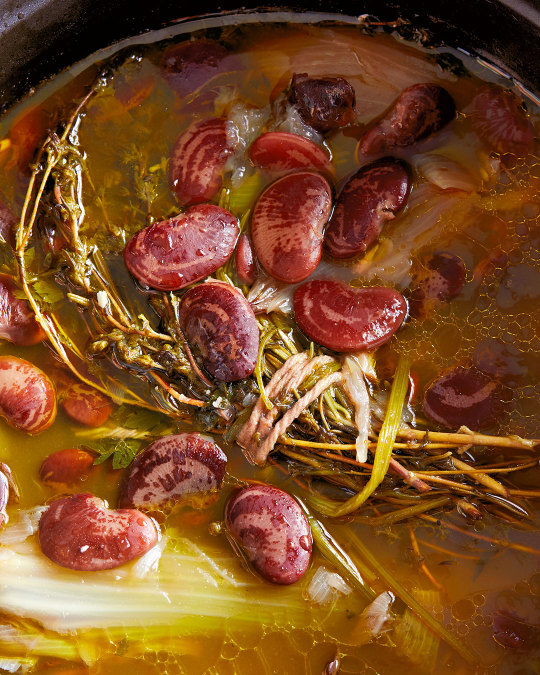
RECIPE: A Pot of Beans (from Colu Cooks by Colu Henry)
I have made beans on a weekly basis for years (mostly on Sundays), so I can use them in meals throughout the week. They are dependable, comforting, and delicious. Not only do they have the ability to serve as a satisfying, delightful meal on their own, they also offer you the flexibility of using them to transform an already existing dish. There isn’t much a bean can’t do.
INGREDIENTS
1 pound (455 g) dried beans
1 tablespoon kosher salt
1 large yellow onion, peeled and halved, or some leek tops, or a few peeled and halved shallots
1 celery stalk with its leaves, cut in half
6 cloves garlic, smashed with the back of a knife, skins discarded
Thyme, rosemary, and parsley sprigs, tied in a bundle with kitchen twine (optional)
Olive oil
SERVES Many
TIME Truly depends on the bean, likely about an hour or so, if soaked beforehand
METHOD
In a large Dutch oven or stockpot, add the beans and the salt and cover them by about 2 inches (5 cm) of water and soak overnight or 6 to 8 hours.
When you’re ready to cook the beans, do not drain them. Add the onion, celery, garlic, and herbs (if using) to the pot of beans. Add more water if needed to make sure the beans are still covered by about 2 inches (5 cm) and drizzle with a good glug or two of olive oil.
Bring the pot of beans to a boil and then turn down the heat to barely a simmer. Skim off any grit and cook until the beans are creamy and tender, adding boiling water along the way, if needed, to make sure your beans stay submerged. This can take anywhere from 1 to 2 hours. Taste your beans along the way; some types of beans will take longer than others. When they are creamy and make you sigh with joy when you bite into a small handful, they are done.
Remove the aromatics, salt to taste, and serve. To store, let cool and then refrigerate them in their broth for up to 1 week or freeze them for up to 6 months.
MAKE IT A MEAL
Weekday Cassoulet: Preheat the oven to 400°F (205 °C). Brown some well-seasoned chicken thighs in canola oil over medium-high heat, then brown a few sausages and set aside. Turn the heat down to medium and sauté finely chopped onion, celery, and garlic. If you have it, adding in a few teaspoons of fresh thyme or rosemary would be nice too. Stir in a handful of crushed tomatoes and some white beans and season with salt and pepper. Transfer the mixture to a 9 by 13-inch (23 by 33 cm) pan and nestle the chicken and sausage in the beans. Bake until the chicken is almost cooked through, 15 to 20 minutes. Top with fresh, coarse breadcrumbs and drizzle with plenty of olive oil. Broil until the top is crispy and golden, a few minutes more.
Tomato Confit and White Bean Stew: Sauté a thinly sliced onion, some garlic, and a pinch of red pepper flakes in a good glug of olive oil over medium heat. Add in 4 cups (680 g) beans and about 1 cup (240 ml) of their cooking liquid; smash ½ cup (85 g) or so of the beans to release some of their creaminess. Season with salt and freshly ground black pepper. Stir in 2 to 3 cups (300 to 450 g) tomato confit or other roasted or canned cherry tomatoes and simmer for 5 to 10 minutes. Taste and adjust seasonings accordingly. Ladle into bowls and shower with a handful of roughly chopped fresh flat-leaf parsley, lemon zest, some grated pecorino cheese, and a drizzle of olive oil.
Pasta e Fagioli Another Way: Toss 2½ to 3 cups (425 to 510 g) borlotti beans with some mezze rigatoni along with some of the bean cooking water to get it nice and saucy. Drizzle with plenty of olive oil and copious amounts of grated pecorino cheese and top with roughly chopped fresh flat-leaf parsley and basil.

NAMED A BEST BOOK OF THE YEAR BY NPR
From New York Times Cooking contributor Colu Henry, a collection of sophisticated recipes for everyday dinners
Colu Henry has been working in food for more than 15 years, and from her time at publications from Bon Appétit to the New York Times, she’s learned that what resonates with her readers is her always unfussy and empowering recipes. In this cookbook—a nod to home cooks who are happy to do everything but pastry—Henry helps readers assemble an amply stocked new-American pantry so that they can perfect (and build upon) classic everyday meals.
With 100 recipes and photographs, Henry offers ideas and solutions to get you out of your weeknight routine, explore new ingredients and techniques, build your confidence, and have a sophisticated dishes on the table in around 45 minutes.
For more information, click here.
#abramsbooks#abrams books#colu cooks#colu henry#recipe#free recipe#easy fancy food#colu cooks easy fancy food#pot of beans#cassoulet#white bean stew#pasta e fagoli
5 notes
·
View notes
Text
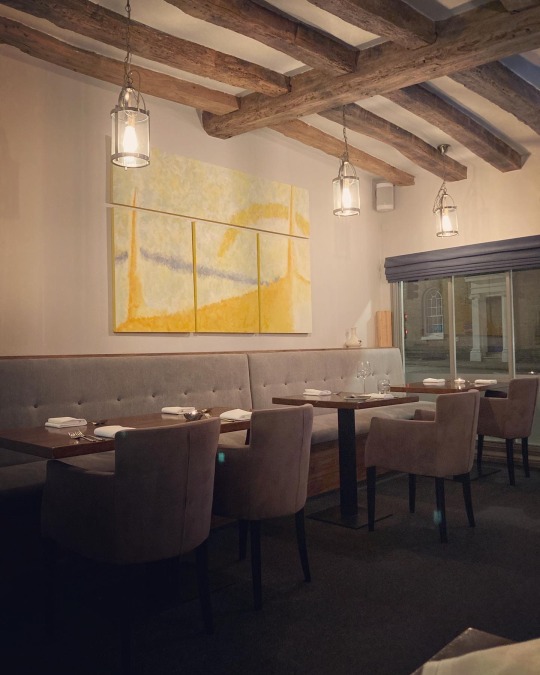

13 May: birthday dinner at 1921 Angel Hill, Bury St Edmunds
this was a special dining experience, as Loverboy took me to a Michelin-starred restaurant for my birthday dinner. it was of course exquisite, and still a very comfortable atmosphere. I tried frogs legs, foie gras, and duck, liked everything except the texture of foie gras, and also enjoyed two delightfully strong cocktails.
more thoughts on each course below, but for now
11/10, definitely recommend, and ideally will make our special spot for future celebratory dinners.

we chose to do the 5 course tasting menu, which began with an assortment of canapés, which are extra-fancy hors d'oeuvres. the selection included smoked tuna on an anchovy cracker, tikka frog leg, mushroom croquette & quail's egg, something with beef tartare, something in caviar, and other things I forget what they were but they were delicious little morsels.
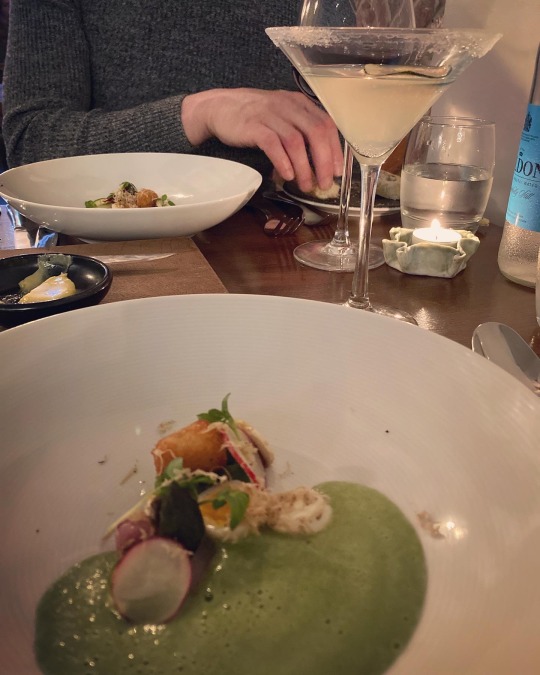
1st course: asparagus soup
this was so delectable it made me tear up a little bit. genuinely. I love asparagus to begin with but this "velouté" was next level. the truffels and quail egg were served in the bowl, and then the creamy velouté was poured at the table. I could have licked the bowl clean if it wouldn't have embarrassed my husband.
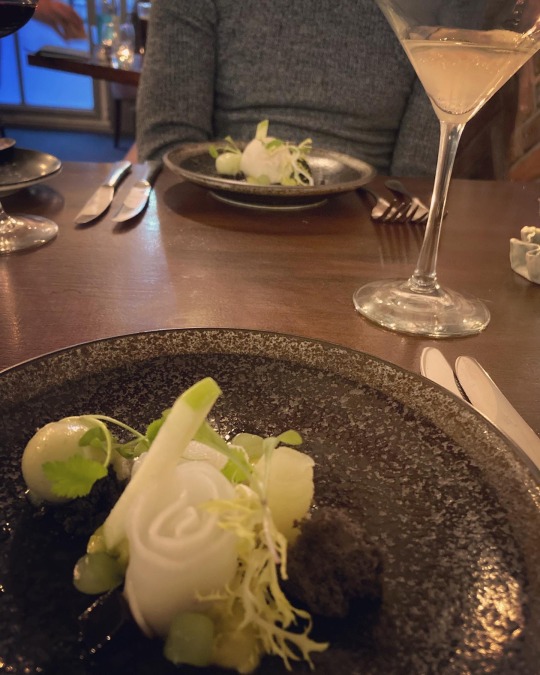
2nd course: wasabi mooli salad
the restaurant was able to accommodate my shellfish allergy, and made this dish without the mersea crab for me. the substitute was simply more pickled mooli (white radish), which was very good but had a very strong flavour on its own. I know I am not one to critique a Michelin star restaurant, but I do wish that they had actually substituted another more mellow-flavoured element in place of the crab. something like grilled chicken or even tofu, but... what do I know! all that to say, this was good but it was the only dish I did not finish as the pickled flavour of the mooli was just too strong to be enjoyed on its own for me.

3rd course: surf n turf but make it fancy ;)
this was another originally-shellfish dish, but they substituted the scallops for seared sea bass on my plate. chicken wings and chicken gravy complimented the fish unexpectedly well, and I could have eaten a whole basket of the morels alone to be honest. If I could order a full dinner sized plate from the tasting menu selection, it would be this dish.

4th course: duck and white bean cassoulet
the seared duck breast was served with rhubarb, and while I loved the duck I was not a fan of the rhubarb. i ate some of it but not all. I also cut the duck meat away from the strip of fat, which my partner said was meant to be eaten together. I cannot stand the texture of animal fat, so I may have committed a faux pas by cutting it off but I wanted to enjoy the duck meat in the way I knew I would.
the little sauce pan served as a side dish contained a white bean cassoulet (beans and shredded beef, but fancy), and foie gras. I imagine the foie gras was imported or produced ethically, as foie gras production is illegal in the UK. I loved the bean and beef cassoulet, but the texture of the foie gras was not very palatable to me.
in order to not make it sound like I didn't enjoy this course, because I very much did, I want to state in no uncertain terms that the duck was i n c r e d i b l e and also I want the white bean cassoulet served with everything else I eat from now on. just without foie gras ;)

5th course: dessert!
the pastry crumbles, the sorbet, the yuzu curd, the pudding-esque caramel-y strip of delicious goop winding beneath it all was *literally chef's kiss* I could kiss the chef for this. my massive sweet tooth wished for more but my rational, polite side knew it was the perfect little bite of sweetness after the savory dishes that preceded it.
again, 11/10 dining experience. I do not know exactly how Michelin stars are earned and maintained, but I dare say this restaurant is certainly deserving. and I want more asparagus velouté soup.
#american in england#get in my belly#fine dining#michelin star#1921 angel hill#angel hill#bury st edmunds#foie gras#veloute#cassoulet#michelin guide#canapes#hors d'oeuvres#mooli raddish#foodie
3 notes
·
View notes
Note
What are your favorite writing tropes for romantic and non-romantic pairings? Can I have your top 5 stew/soup choices?
Also your billy joel take is half-wrong but I love you anyways
Which half my my Billy Joel take is wrong???
Hmm. I don't really think about writing non romantic pairings much? I guess I write Robin and Steve's friendship a little but I don't really think of it in trope terms. I like silliness, anything very stupid. So any kind of friends-encouraging-each-others-shenanigans is fun for me. I just also like trying to make it clear in not a lot of words (because again i tend to write everyone who isn't robin and nancy very sparsely) that they just love each other a lot. Trust and loyalty etc.
For romantic relationships i mean first of all there cannot be more than one bed. I love fake dating though ive never written it i would love to someday. I love reading enemies/rivals to lovers but so far whenever i try to start them out as rivals it's like, nah, they are too soft for each other already sorry. The main thing I tend to write over and over is the "idiots who are in love and just either dont know it or wont admit it yet". It's just where this pairing lives most comfortably for me.
Soups and Stews oh man. This list is not in order, and is non-binding and subject to change. At this very moment these are the soups and stews i would like to have:
Green chili, either a quick after work version with chicken or a richer all day version with pork shoulder
Im calling cassoulet a stew. I am still thinking about the cassoulet i made a couple months ago, i need to make it again.
Classic beef stew with red wine and shallots and mushrooms and carrots and maybe there's potatoes in there or maybe you go buck wild and serve it over mashed potatoes
The Best Chili Ever recipe on serious eats. it's so good bro.
I would never say no to a classic chicken noodle soup
3 notes
·
View notes
Photo

New Year’s goose leftovers part 1, cassoulet. Made with instant pot flageolet beans, bratwurst, and saucisson, simmered for 3 hours. This one got a nice crust, but was a bit dry when it was finished, so I added back some more of the reserved bean/chicken broth. #dinner #newyearseve #cassoulet #instantpot #goose
3 notes
·
View notes
Link
#BeefStew#BisqueRecipes#BrothRecipes#ChickenStew#ChiliRecipes#ChowderRecipes#ComfortSoup#HeartyStew#InstantPotSoup#SeafoodStew#SlowCookerSoup#SoupRecipes#StewRecipes#VegetableSoup#WinterSoup
1 note
·
View note
Text
Culinary Journeys Unveiled: A Food Lover's Guide to Authentic Global Tastes
Embarking on a culinary journey introduces travelers to new tastes, ingredients, and cooking methods that embody different cultures. Food is not just sustenance—it's an art form and a cultural statement that speaks volumes about the people who make and enjoy it. Explore the world through a food lover’s guide that takes you from the intricate flavors of Asian street markets to the comforting hearths of European kitchens.
Thailand: Street Food Extravaganza
Thai cuisine tantalizes the taste buds with its sour, sweet, salty, and spicy flavors. Bangkok's street food scene is unmatched, from fiery papaya salad (som tum) to the ubiquitous pad thai. In the north, khao soi, a coconut milk-based curry soup with crispy noodles, represents Chiang Mai's heritage. Green, red, and massaman curry vary in flavor, but each boasts a signature blend of spices. Remember sticky rice with mango for dessert.
India: Spices and Diversity
India’s diverse regional cuisines present a whirlwind of flavors. The aromatic spices of biryani and tandoori dishes reflect Mughal influences in the north. In the south, dosas (crispy rice crepes) and sambar (lentil stew) are everyday staples. West Bengal’s fish curries boast mustard and coconut flavors, while Gujarat's vegetarian dishes are distinct with sweet-savory combinations. Enjoy chaat (street snacks) like pani puri, a crisp sphere filled with spicy water, and end on a sweet note with kulfi.
France: Artistry and Technique
French cuisine celebrates artistry, with regional specialties that have become global classics. Paris is synonymous with croissants and baguettes, while Lyon is known for its bouchons, which serve coq au vin and quenelles. Cassoulet, a slow-cooked bean stew, embodies the hearty cuisine of the Southwest. In Alsace, choucroute garnie (sauerkraut with meats) reflects German influences. Savor delicate pastries like mille-feuille or a rich crème brûlée, and pair your meal with world-renowned French wines.
Italy: Simplicity and Tradition
Italian cuisine revolves around high-quality ingredients and traditional techniques. In Rome, savor carbonara with pecorino and guanciale. In the north, the rice-growing regions are known for risotto alla Milanese, while in the south, Naples is famed for its Neapolitan pizza. Fresh seafood dishes like spaghetti alle vongole reflect Italy’s coastline. Enjoy tiramisu or cannoli for dessert, and finish with a shot of espresso or a glass of limoncello.
Spain: Festive and Flavorful
Spanish cuisine is best enjoyed as a communal feast. Tapas, ranging from patatas bravas to gambas al ajillo, allow diners to sample many flavors in one meal. In Andalusia, gazpacho provides a refreshing reprieve, while the Basque region’s pintxos elevate snacking to an art form. Paella, whether seafood or meat-based, is a Valencian treasure. Finish with churros dipped in chocolate or crema catalana.
Mexico: Layers of Flavor
Mexican cuisine is a layered tapestry of indigenous and colonial influences. Tacos served with al pastor or carnitas, are a street food staple, while mole sauce (made from chocolate, spices, and chiles) transforms any dish. Savor tamales wrapped in corn husks or enchiladas drenched in salsa verde. In Oaxaca, sample tlayudas, a large, crisp tortilla topped with beans and cheese. Wash it all down with horchata or an agave-based mezcal.
Peru: Coastal and Highland Splendor
Peruvian cuisine showcases its rich geography. Ceviche is a bright blend of citrus, fish, and chili along the coast. Hearty stews like aji de gallina (creamy chicken) and papas a la huancaína (potatoes in a spicy cheese sauce) are comforting in the highlands. Pachamanca, an ancient Incan technique, involves cooking meat underground with hot stones. Quinoa and native potatoes are heavily featured, while pisco sour remains the national cocktail.
Brazil: Regional Abundance
Brazil's food varies significantly across regions. In the northeast, the Afro-Brazilian influences of acarajé (black-eyed pea fritters) and moqueca (fish stew) reign. In the south, churrasco (barbecue) includes various cuts of beef cooked over open flames. The national dish, feijoada, is a black bean stew with pork, while pão de queijo (cheese bread) is a cheesy snack. Pair your meal with a caipirinha made with cachaça.
Turkey: Ancient and Modern
Turkish cuisine bridges continents and traditions. Start with meze like hummus, baba ghanoush, and dolma (stuffed grape leaves)—kebabs, whether shish or doner, are grilled to perfection. The palace cuisine of the Ottoman era comes alive with dishes like hünkar beğendi (lamb over eggplant puree) and pilav. Sample baklava or künefe (cheese pastry soaked in syrup) with a cup of strong Turkish coffee for dessert.
Lebanon: Mezze and More
Lebanese food is colorful and generous. Mezze, a spread of small dishes like tabbouleh, labneh, and muhammara (spicy walnut dip), invites sharing. Kibbeh (ground meat with bulgur), manakish (za'atar flatbread), and shawarma provide savory satisfaction. Grilled meats and seafood continue the feast, ending with knafeh (cheese pastry) and baklava.
Iran: Saffron and Tradition
Iranian cuisine is traditional and marked by saffron, rosewater, and pomegranate. Rice is integral, whether tahdig (crispy rice) or jeweled rice with fruits and nuts. Fesenjan, a rich pomegranate and walnut stew, pairs well with chicken. Ghormeh sabzi, a herb stew, exemplifies balance. Cool off with a Persian cucumber salad or sharbat (floral syrup drink).
Morocco: Fragrant and Flavorful
Moroccan cuisine fills the senses with its fragrant spices and communal spirit. Tagine simmered in a conical pot features meats and vegetables with olives and preserved lemon. Couscous often served with seven vegetables, is a Friday family tradition. Pastilla, a flaky pastry filled with pigeon, chicken, and almonds, melds savory and sweet. For dessert, try chakra or spend (Moroccan doughnuts).
Ethiopia: Communal and Hearty
Ethiopian cuisine centers around injera, a sourdough flatbread made from teff flour. Wat (stew) is placed atop the injera, with dishes like doro wat (spicy chicken stew) or shiro (chickpea). The communal nature of Ethiopian dining encourages sharing from one large platter. The meal ends with a traditional coffee ceremony, highlighting the importance of hospitality.
South Africa: Rainbow Cuisine
South African cuisine blends indigenous, colonial, and immigrant influences. Bobotie, a Cape Malay curried meat dish topped with egg custard, is iconic. Biltong, dried and cured meat, and boerewors, a spiced sausage, highlight the country's love for meat. Potjiekos (stew cooked in a cast-iron pot) reflects Dutch heritage. For dessert, try malva pudding with a glass of South African wine.
Culinary journeys provide a deeper understanding of the world’s cultures and traditions, highlighting the stories behind every ingredient and recipe. Whether you prefer spicy, sweet, or savory, there's a dish out there waiting to tantalize your taste buds and transport you to another place. Step outside your culinary comfort zone and start your journey today.
0 notes
Photo

Chef John's Quick Cassoulet Recipe
In order to prepare a quick version of the French classic cassoulet, we've taken some shortcuts. Chicken thighs take the place of the traditional and labor-intensive duck confit, dried beans are swapped out for canned, and bacon stands in for other, more complex smoked pork options. 1 cup bread crumbs, 1/4 cup melted butter, salt and pepper to taste, 2 cans cannellini beans drained and rinsed, 2 cups chicken broth plus more if needed, 8 ounces smoked sausage sliced, 4 ounces bacon cut into 1 inch pieces, 1 onion diced, 1/2 cup finely grated Parmigiano-Reggiano, 1.5 teaspoons minced fresh thyme, cayenne pepper to taste, 12 ounces boneless skinless chicken thighs cubed, 1.5 teaspoons minced fresh rosemary
0 notes
